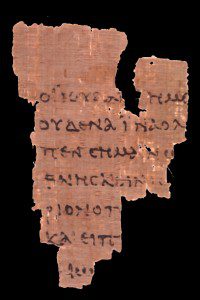Part 7 of series:
Ancient Ephesus and the New Testament
Artemis and Her Temple

In my last post, I summarized the beginning of Paul’s ministry in Ephesus as it’s described in Acts 19. We saw that, after first being stymied in his effort to reach out to Ephesian Jews through the synagogue, Paul switched to a lecture hall, where he experienced a more positive response to his preaching. In fact, the success of Paul’s ministry led to a major disturbance in the city. In order to grasp the nature of this uproar, we must understand one of the most important facts about ancient Ephesus: it was home to the temple of Artemis.
In 2007, a survey of 100 million voters resulted in a new list of the Seven Wonders of the World. In its current state, the Temple of Artemis would never make such a list. But in its heyday, which includes the first century A.D., this temple was considered one of the Seven Wonders of the World. It was one of the largest temples in the world and drew visitors from far and wide.

The goddess Artemis was a combination of the Greek goddess named Artemis, the virginal goddess of the hunt, and a local goddess with a very different job identity. In Asia Minor, the region of Ephesus, this Greek goddess was combined with elements associated with the Anatolian goddess Cybele, who was associated with the earth and with fertility, and was sometimes known as the Great Mother. (Yes, the Ephesian Artemis somehow combined the virginal Artemis with Cybele, the fertile mother. The photo to the right shows a statue of Artemis that was found at Ephesus and is now prominently displayed in the Ephesian museum. The “crown” on her head is a representation of the temple. The “eggs” surrounding her midsection are perhaps some fertility symbol, though scholars don’t agree on their denotation.)

For Ephesus, having the temple of Artemis nearby (about a mile from the main city) was a great boon. On the one hand, the presence of such a temple demonstrated the importance of Ephesus and was thought to bring special blessing upon the city. On the other hand, worshipers came from all around to visit the temple, and in so doing spent lots of money on lodging, offerings, souvenirs, and so forth.
Today, little is left of the temple of Artemis. You must use your imagination to picture its former glory. There is, however, a model of the temple in the museum which can help to fill in the blanks.

Ironically, you can see more of the temple of Artemis into two distant locations. The British Museum in London displays portions of the pillars represented in the model to the right. A couple of large pillars, purportedly from the temple of Artemis, are integral to the Hagia Sophia in Istanbul.
Therefore, anything that threatened the prominence of Artemis and her temple would have been seen as a major threat to Ephesus itself. In my next post we’ll see how this played out in Acts 19.











